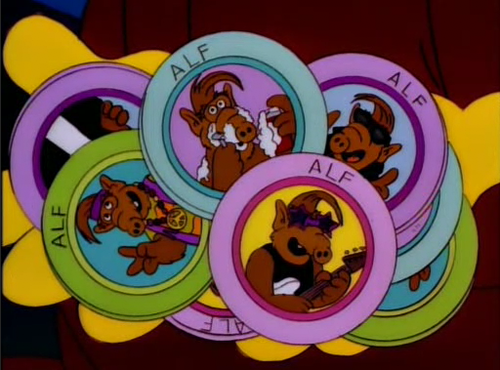14
Mar
2012
Whatever Happened To. . . Webrings
Today while surfing around in Wikipedia, like I tend to do, one of the footnotes in the article I was reading was a link to a GeoCities page in the Wayback Machine. It was my understanding that individual GeoCities sites did not get archived, so imagine my delight when I did a search and the first website I ever designed after teaching myself HTML using AOL’s online tutorial back in the summer of 1994 was still available. What was that site? It was the Original Amy Jo Johnson Webring. I was originally going to steal and rewrite like the one good Amy Jo Johnson website because it was all frames and had a horrible layout, but halfway through he beat me to it, so I decided to make a Webring and have his site be the inaugural member. Yes, it’s embarrassing, but I’m not ashamed. I listed it as an extracurricular activity on my application to the National Honor Society, right along with Knowledge Bowl and being JV Chess Captain. Needless to say, I did not get in. That’s all the setup we need for today’s look back to the very dawn of the internet, where I shall endeavor to answer: Whatever Happened To Webrings?
 |
It may be hard to believe, but there was once a time on the internet before Google existed. In those dark times, when you wanted to look for something, you had to use a site like WebCrawler, Lycos, Alta Vista (unless you live and Pawnee and are still using it), and Yahoo. Yahoo back then wasn’t so much a search engine, as it was a phonebook. It was a hierarchical listing of websites grouped together by subject. There was no ranking based on link count, it was just a flat list. Unlike nowadays, when anything you post online shows up in Google in like 3 minutes, back then getting listed in a search engine was an active process. You needed to go to a registration website on each search engine, submit your site details, you would self categorize your site, and then wait 8 to 12 weeks for it to show up. It was kind of insane. And you needed to submit to each one individually, they didn’t cross reference.
So a bunch of nerds thought of a different way to link content, which looking back seems kinda silly, or otherwise like the theory of Quantum Leap. What if you took all the pages that had a similar content, and linked them together, so that you could reach any one from any other one? If you lined them all up, then link the first and last, you’d have a ring of sites all about the same thing. And that, in a nutshell, is what a Webring was. (In Software Engineering parlance, all it was a deque of sites with a web frontend).
How this worked was all the sites in the ring would have the same navigation banner on them like the one below which had different links to different Webring functions (go back one entry, go forward one entry, go to a random entry, list all entries, etc.) The Webring was all managed through a bunch of cgi scripts on the Webring controller website, the best known one being Webring.org. The Ringmaster was in charge of finding new sites to add to the ring, and making sure sites added their banners and other ring management issues, like removing dead sites, etc.

|
| Check out this bitchin’ client side imagemap I made. I spent like 3 days doing this by hand back in the day. I’m sure there is a jQuery plugin that will do this now in like 8 seconds. |
That all sounds fine in theory, but in practice it didn’t work out so well. Legitimate sites almost never belonged to Webrings. There was never a “News” Webring with like member sites of CNN and the Washington Post. What you ended up with was just a collection of poorly written amateur websites, like “Bill’s totally awesome Beast Wars and Reboot fan page!” that were all pretty much the same, a few pictures on topic and that was about it. They tended to be about TV shows, Actors and Actresses, Cars or Sports teams. Most Webrings never really got more than 20 sites because back then the learning curve to make a website was a lot steeper, and as such there weren’t as many people doing it so there would only ever be so much content. And in an effort to get exposure for their sites, people would join as many Webrings as they could, leading to pages just pull of banners.
 |
| Can you imagine getting hit with 20 of these when you loaded a page? |
So while it may not have been the most elegant of things, if you found a good ring about something you were interested in, you could likely find some cool stuff. So why aren’t they around anymore? Well, apparently they are (that imagemap actually still works, but there is only one site left in the ring), but you wouldn’t know it. The reason Webring.org fell apart is a weird succession of sales and mergers. The initial programmers sold the company to an investment firm in 1997. The investors turned around and sold to GeoCities in 1998. This made a lot of sense, as a great deal of sites comprising Webrings were pages made and hosted through GeoCities. Both these sales were pretty transparent, with no changes to the functionality of any Webrings. However, in 1999 Yahoo bought out GeoCities, and tried to merge the Webrings with existing Yahoo content. This was disastrous. You now needed a Yahoo screenname to manage the Webring, which is fine, but the execution was totally botched. It turns out they didn’t keep track of the Ringmaster as part of the transition. Whoever was the first person in the Webring to login and associate themselves with the ring became the new Ringmaster and had all the management rights. I still controlled the website and public facing presence for the Webring, with all the info about it and how to join, but I could no longer actively manage it, some random dude did.
This was not an isolated circumstance, and a great number of Webrings basically became defunct overnight, as there were no longer people able to manage them, and those who wanted to couldn’t. Webrings became frozen in time, unable to be changed. Yahoo messed up the transition so badly, they actually threw their hands up and just walked away, selling it back to one of the original developers in 2001. He re-released it several months later, but by that time it was too late. Users had been so burned, most sites removed their banners. And by that point, there wasn’t much of a need for them anymore. Yahoo had matured into a full fledged search engine, and Google was just starting it’s rise. It was no longer as hard to find the content you were looking for. Webring.org is still around, trying to turn into some type of banner add thing and make money, but it isn’t working. I haven’t seen a link to a Webring in at least 10 years (at least on a new site, plenty of dead sites that are older than 12 years still have them). Basically it was a shift in the power of online search engines, and a series of failed mergers, that lead to the death of the Webring.
|
|









